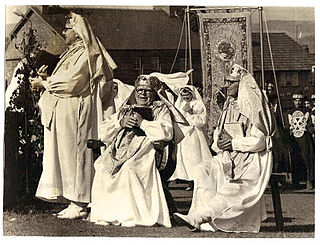Related Research Articles

The Battle of Badon /ˈbeɪdən/ also known as the Battle of Mons Badonicus was a battle purportedly fought between Britons and Anglo-Saxons in Post-Roman Britain in the late 5th or early 6th century. It was credited as a major victory for the Britons, stopping the encroachment of the Anglo-Saxon kingdoms for a period.

Rhodri ap Merfyn, later known as Rhodri the Great, succeeded his father, Merfyn Frych, as King of Gwynedd in 844. Rhodri annexed Powys c. 856 and Seisyllwg c. 871. He is called "King of the Britons" by the Annals of Ulster. In some later histories, he is referred to as "King of Wales", although the title is anachronistic and his realm did not include southern Wales.

Gruffudd ap Cynan, sometimes written as Gruffydd ap Cynan, was King of Gwynedd from 1081 until his death in 1137. In the course of a long and eventful life, he became a key figure in Welsh resistance to Norman rule, and was remembered as King of all Wales. As a descendant of Rhodri Mawr, Gruffudd ap Cynan was a senior member of the princely House of Aberffraw.
Cynan ab Iago was a Welsh prince of the House of Aberffraw sometimes credited with briefly reigning as King of Gwynedd. His father, Iago ab Idwal ap Meurig, had been king before him and his son, Gruffudd, was king after him.
Calennig[kaˈlɛnɪɡ] is a Welsh word meaning "New Year celebration/gift", although it literally translates to "the first day of the month", deriving from the Latin word kalends. The English word "Calendar" also has its root in this word.
Merfyn Frych, also known as Merfyn ap Gwriad and Merfyn Camwri, was King of Gwynedd from around 825 to 844, the first of its kings known not to have descended from the male line of Cunedda.

Sir (Albert) Cynan Evans-Jones CBE, more commonly known within Wales by his bardic name of Cynan, was a Welsh war poet and dramatist.
Merfyn ap Rhodri was a late 9th-century Aberffraw prince of Gwynedd. He is sometimes credited with ruling Powys after the death of his father Rhodri the Great in AD 878. In the accounts where he is credited as a king, he is reported to have lost his realm to an invasion by his brother Cadell, King of Ceredigion. Merfyn's death may be connected to the incursion into Anglesey by the Viking Ingimundr in the first decade of the 10th century.

Llanfaes is a small village on the island of Anglesey, Wales, located on the shore of the eastern entrance to the Menai Strait, the tidal waterway separating Anglesey from the north Wales coast. Its natural harbour made it an important medieval port and it was briefly the capital of the kingdom of Gwynedd. Following Prince Madoc's Rebellion, Edward I removed the Welsh population from the town and rebuilt the port a mile to the south at Beaumaris. It is in the community of Beaumaris.
Brut y Brenhinedd is a collection of variant Middle Welsh versions of Geoffrey of Monmouth's Latin Historia Regum Britanniae. About 60 versions survive, with the earliest dating to the mid-13th century. Adaptations of Geoffrey's Historia were extremely popular throughout Western Europe during the Middle Ages, but the Brut proved especially influential in medieval Wales, where it was largely regarded as an accurate account of the early history of the Celtic Britons.
The Battle of Pencon or Pencoed was a battle won by the Britons, possibly against the Mercians or against themselves, around the year 720.
Gwriad ap Elidyr or Gwriad Manaw was a late-8th century figure in Wales. Very little is known of him, and he chiefly appears in the historical record in connection to his son Merfyn Frych, King of Gwynedd from around 825 to 844 and founder of the Merfynion dynasty.
Ffernfael ab Idwal or Ithel was a late 8th-century king of Gwent in southeast Wales.
Sadyrnfyw or Sadwrnfen the Generous was a bishop of Meneva in medieval Wales.
Nobis or Novis is traditionally considered to have been a bishop of Meneva in the medieval Welsh kingdom of Dyfed.

The Chronicle of the Saxons is a Welsh-language chronicle running from 683 to 1197. One manuscript attributes it to Caradog of Llancarfan. It appears to consist primarily of passages of the Chronicle of the Princes and the Annals of Winchester, with other minor sources as well.
Rhodri ab Idwal was a 10th-century prince of Gwynedd from the royal dynasty of Aberffraw.
Gwriad ap Merfyn or ap Rhodri was a 9th-century prince of Gwynedd in northern Wales. He is an obscure figure, sometimes being listed as Rhodri the Great's brother and sometimes as his son.
Mawddwy is a community in the county of Gwynedd, Wales, and is 88.3 miles (142.2 km) from Cardiff and 172.8 miles (278.0 km) from London. In 2011 the population of Mawddwy was 622 with 59.5% of them able to speak Welsh. It is one of the largest and most sparsely populated communities in Wales.
Thomas Wiliems was a Welsh-language antiquarian.
References
- 1 2 Harleian MS. 3859. Op. cit. Phillimore, Egerton. Y Cymmrodor 9 (1888), pp. 141–83. (in Latin)
- ↑ Public Records Office MS. E.164/1, p. 10. (in Latin)
- ↑ British Library MS Cotton Domitian A.1, p. 140. (in Latin)
- 1 2 Archaeologia Cambrensis: "Chronicle of the Princes", p. 15. Accessed 27 Feb 2013.
- ↑ Williams, William. Prydnawngwaith y Cymry, neu Fer Hanes o Lywodraeth y Tywysogion Cymreig ar Gymru, yr Hon a Barhaodd o'r Flwyddyn o Oed ein Hiachawdwr 686 Hyd y Flwyddyn 1283, p. 22. J. Jones, 1822. Accessed 27 Feb 2013. (in Welsh)